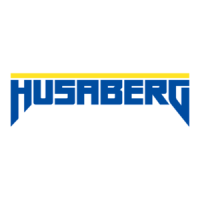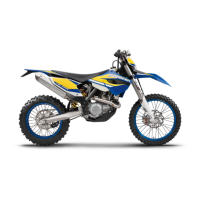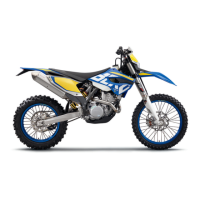Do you have a question about the HUSABERG FE 450 EU and is the answer not in the manual?
Explains the meaning of specific symbols used in the manual.
Details the typographical formats employed within the document.
Specifies the intended use and operational restrictions for the HUSABERG sport motorcycles.
Provides essential safety instructions for operating the vehicle correctly and safely.
Defines the risk categories and associated symbols for potential hazards.
Warns against tampering with the noise control system and related laws.
Outlines crucial guidelines for safe operation, including environmental compatibility.
Emphasizes the importance of wearing appropriate protective clothing for rider safety.
Details general work rules, including the use of special tools and replacement parts.
Addresses environmental responsibility and proper disposal of fluids and components.
Highlights the importance of reading and keeping the Owner's Manual for proper vehicle operation and maintenance.
Explains warranty conditions and the importance of authorized service for claims.
Provides guidance on handling operating fluids and environmental hazards.
Recommends using approved spare parts and accessories for safety and performance.
Stresses the necessity of proper service and maintenance for optimal performance and longevity.
Notes that manual figures may show special equipment and be partially disassembled.
Directs users to authorized dealers for any questions regarding the vehicle or HUSABERG.
Illustrates the front left view of the vehicle with numbered components.
Illustrates the rear right view of the vehicle with numbered components.
Shows the location where the chassis number is stamped on the steering head.
Indicates the location of the type label on the front of the steering head.
Shows where the key number for the steering lock is stamped.
Identifies the location of the engine number on the engine's left side.
Shows the location of the fork part number on the inner side of the fork stub.
Indicates the location of the shock absorber part number on the shock absorber.
Describes the location and operation of the hydraulically operated clutch lever.
Details the location and function of the hand brake lever for the front brake.
Specifies the location of the throttle grip on the right handlebar.
Explains the function and positions of the kill switch for EU/AUS models.
Explains the function and positions of the kill switch for USA models.
Describes the location and operation of the horn button.
Details the function and positions of the light switch for EU/AUS models.
Explains the function and positions of the light switch for USA models.
Describes the location and operation of the turn signal switch.
Explains the function and positions of the emergency OFF switch.
Details the location and operation of the electric starter button.
Details the location and operation of the electric starter button.
Explains the various indicator lamps and their meanings for EU/AUS models.
Explains the various indicator lamps and their meanings for USA models.
Provides instructions and safety warnings for opening the fuel filler cap.
Details the procedure for correctly closing the fuel filler cap and routing the breather hose.
Explains the location and function of the idle speed adjusting screw.
Describes the location and gear positions of the shift lever.
Details the location and operation of the foot brake lever for the rear brake.
Explains the location and use of the side stand, including securing it when riding.
Describes the location and function of the steering lock.
Provides steps and precautions for locking the steering mechanism.
Details the procedure for unlocking the steering mechanism.
Provides an overview of the speedometer display and its buttons.
Explains how the speedometer is activated.
Describes possible messages displayed on the speedometer, such as service reminders.
Outlines the procedure for setting the speedometer units and clock display.
Details how to change the unit of measure for speed and distance.
Explains how to set the 12h or 24h clock display and reset the time.
Guides on setting service intervals and switching off the service display.
Explains how to view speed, time, and a distance measurement (DST 1).
Details how to view speed, time, and a second distance measurement (DST 2).
Describes how to view average speed, operating hours, and total distance covered.
Offers essential advice for the initial use of the motorcycle, including safety and controls.
Provides guidelines for the engine's running-in period to ensure optimal performance and longevity.
Advises on preparing the vehicle for challenging conditions like sand or mud.
Details specific preparations for riding the motorcycle on dry sand.
Outlines necessary preparations for riding the motorcycle on wet sand.
Provides guidance on preparing the motorcycle for wet and muddy terrain.
Offers advice for riding in high temperatures and at slow speeds.
Details preparations for operating the motorcycle in cold conditions or snow.
Lists essential checks and maintenance tasks to perform before riding.
Covers safety precautions and procedures for starting the motorcycle's engine.
Explains how to start moving the motorcycle from a standstill.
Provides instructions on gear shifting, riding techniques, and throttle control.
Details braking techniques, precautions, and advice for different conditions.
Covers procedures and safety notes for stopping and parking the motorcycle.
Offers guidance on safely transporting the motorcycle.
Provides instructions and safety warnings for refueling the motorcycle.
Presents a detailed schedule of maintenance tasks at various operating hour intervals.
Lists service tasks that can be performed as additional orders at specific intervals.
Explains how to adjust the basic chassis settings based on rider weight for optimal handling.
Introduces the concepts of high-speed and low-speed compression damping for the shock absorber.
Provides instructions on how to adjust the low-speed compression damping of the rear shock absorber.
Details the procedure for adjusting the high-speed compression damping of the rear shock absorber.
Guides on how to adjust the rebound damping of the rear shock absorber.
Explains how to measure the rear wheel sag when the motorcycle is unloaded.
Describes how to check the static sag of the rear shock absorber and adjust spring preload.
Details how to check the riding sag of the rear shock absorber and adjust it.
Provides step-by-step instructions for adjusting the spring preload of the rear shock absorber.
Explains how to adjust the riding sag, including selecting appropriate springs.
Discusses checking the basic settings of the front fork and compensating for rider weight differences.
Details how to adjust the compression damping settings for the front fork.
Guides on adjusting the rebound damping settings for the front fork.
Explains the options for positioning the handlebar on the upper triple clamp.
Provides instructions and safety warnings for adjusting the handlebar position.
Details the procedure for safely raising the motorcycle using a lift stand.
Explains how to safely remove the motorcycle from a lift stand.
Guides on bleeding the fork legs to release excess pressure.
Provides instructions for cleaning the dust boots on the fork legs to prevent seal damage.
Details the steps for loosening and removing the fork protectors.
Explains how to position and secure the fork protection on the fork legs.
Provides instructions for removing the front fork legs from the motorcycle.
Details the procedure for installing the front fork legs, including tightening sequences.
Outlines the steps for removing the fork protectors.
Provides instructions for installing the fork protectors onto the fork legs.
Details the procedure for removing the lower triple clamp and associated components.
Guides on installing the lower triple clamp, including fork leg positioning and tightening.
Explains how to check for play in the steering head bearing and its importance.
Provides instructions for adjusting the steering head bearing play to eliminate looseness.
Details the process of lubricating the steering head bearings.
Outlines the steps for removing the front fender.
Provides instructions for installing the front fender.
Details the procedure for removing the rear shock absorber.
Guides on installing the rear shock absorber, including tightening specifications.
Explains how to remove the motorcycle seat.
Provides instructions for mounting the motorcycle seat.
Details how to remove the air filter box lid.
Explains how to install the air filter box lid.
Guides on removing the air filter, emphasizing its importance for engine life.
Provides instructions for installing a clean air filter, including greasing.
Details the proper procedure for cleaning the air filter and air filter box.
Explains how to seal the air filter box in a specific marked area.
Provides instructions for removing the main silencer, with warnings about heat.
Guides on installing the main silencer, including mounting and tightening.
Explains how to change the glass fiber yarn filling in the main silencer, noting its effects on noise and performance.
Details the procedure for removing the right side cover.
Provides instructions for installing the right side cover.
Guides on removing the fuel tank, including safety precautions for fuel handling.
Details the procedure for installing the fuel tank, with safety warnings related to fuel.
Explains how to check the chain for dirt accumulation.
Provides instructions for cleaning and maintaining the motorcycle chain.
Explains how to check the chain tension and the consequences of incorrect tension.
Provides instructions for adjusting the chain tension correctly.
Guides on checking wear and condition of the chain drive components.
Details how to check the motorcycle frame for cracks or deformation.
Explains how to inspect the swingarm for damage, cracking, or deformation.
Guides on checking the correct routing of the throttle cables.
Explains how to check the handlebar rubber grips for damage or wear.
Details how to further secure the rubber grips using securing wire.
Provides instructions for adjusting the clutch lever position for rider comfort.
Guides on checking and correcting the hydraulic clutch fluid level.
Details the procedure for changing the hydraulic clutch fluid, including environmental warnings.
Explains how to remove the engine guard.
Provides instructions for installing the engine guard.
Explains how to check the free travel of the hand brake lever and potential issues.
Guides on adjusting the free travel of the hand brake lever for EU/AUS models.
Details adjusting the hand brake lever position for USA models.
Explains how to check the thickness and condition of the front and rear brake discs.
Guides on checking the front brake fluid level and potential causes for low levels.
Provides instructions for adding front brake fluid, including safety warnings.
Explains how to check the front brake linings for minimum thickness and condition.
Details the procedure for changing the front brake linings, including safety and product warnings.
Guides on checking the free travel of the foot brake lever and its importance for rear brake function.
Provides instructions for adjusting the basic position of the foot brake lever.
Guides on checking the rear brake fluid level and potential issues.
Details how to add rear brake fluid, including safety warnings.
Explains how to check the rear brake linings for minimum thickness and condition.
Details the procedure for changing the rear brake linings, with safety and product warnings.
Provides instructions for removing the front wheel, including brake caliper adjustment.
Guides on installing the front wheel, including wheel bearing checks and spacer installation.
Details the procedure for removing the rear wheel, including chain and brake caliper adjustments.
Guides on installing the rear wheel, including chain tension and brake activation.
Explains how to check tire condition, including cuts, damage, and tread depth.
Provides guidelines for checking and maintaining correct tire air pressure for optimal performance.
Details how to check spoke tension and the importance of correct tension for wheel stability.
Guides on safely removing the motorcycle battery, including precautions for acid.
Provides instructions for installing the motorcycle battery, including cable connections.
Details the procedure for charging the motorcycle battery and related safety precautions.
Explains how to locate and change the main fuse for the electrical system.
Guides on changing fuses for individual electrical components.
Details the procedure for removing the headlight mask and headlight assembly.
Provides instructions for installing the headlight mask and headlight assembly.
Guides on changing the headlight bulb, including precautions for the reflector.
Details how to change the turn signal bulb for EU/AUS models.
Explains how to check and verify the correct headlight aiming.
Provides instructions for adjusting the headlight beam range.
Guides on changing the battery for the speedometer unit.
Provides a general overview of the cooling system and its components.
Details procedures and warnings for checking antifreeze and coolant levels.
Explains how to check the coolant level in the radiator, with warnings.
Guides on draining the coolant from the cooling system, with safety warnings.
Provides instructions for refilling the cooling system with coolant.
Explains how to check the throttle cable for correct play and its effect on idle speed.
Guides on adjusting the throttle cable play to ensure proper throttle grip operation.
Details how to adjust the engine's idle speed using the adjusting screw.
Explains how to check the shift lever position relative to the rider's boot.
Guides on adjusting the shift lever's position for comfortable gear changes.
Details the procedure for changing the fuel screen, including safety precautions.
Explains how to check the engine oil level and when to add oil.
Provides comprehensive instructions for changing engine oil, filter, and cleaning oil screens.
Guides on adding engine oil to the correct level, with notes on oil quality.
Details the proper procedure for cleaning the motorcycle, including precautions.
Outlines essential checks and maintenance for winter storage and operation.
Provides detailed steps for storing the motorcycle for extended periods.
Guides on preparing the motorcycle for use after it has been stored.
Lists detailed specifications for the motorcycle's engine.
Provides a table of specified tightening torques for various engine components.
Lists the capacities for engine oil, coolant, and fuel.
Provides technical specifications related to the motorcycle's chassis components.
Lists electrical system specifications, including battery, fuses, and lighting.
Provides details on tire specifications and validity for different models.
Lists technical specifications for the front fork, including damping and spring rates.
Provides technical specifications for the rear shock absorber, including damping and sag.
Lists chassis tightening torques for various fasteners and components.
Specifies standards and recommendations for brake fluid.
Provides recommendations and mixture ratios for coolant.
Specifies standards and recommendations for fork oil.
Provides recommendations for shock absorber oil.
Specifies fuel grade requirements and fuel compatibility.
Recommends specific agents for cleaning the air filter.
Recommends specific products for cleaning the motorcycle chain.
Recommends specific products for lubricating and protecting the chain.
Recommends cleaning and polishing products for various surfaces.
Recommends cleaning and polishing materials for metal, rubber, and plastic parts.
Recommends specific fuel additives for storage or improved performance.
Recommends specific high viscosity greases for lubrication.
Recommends specific long-life greases for lubrication.
Recommends specific motorcycle cleaning agents.
Recommends specific oils for lubricating foam air filters.
Specifies the recommended adhesive for rubber grips.
Recommends a specific universal oil spray.
Explains the JASO T903 MA standard for 4-stroke motorcycle oils.
Explains the SAE system for classifying oil viscosity.
| Brand | HUSABERG |
|---|---|
| Model | FE 450 EU |
| Category | Motorcycle |
| Language | English |











